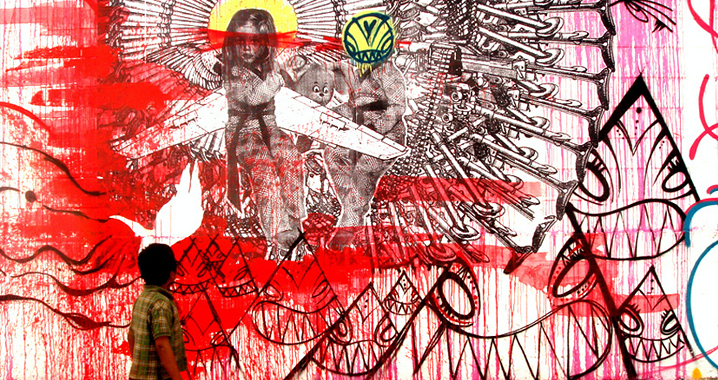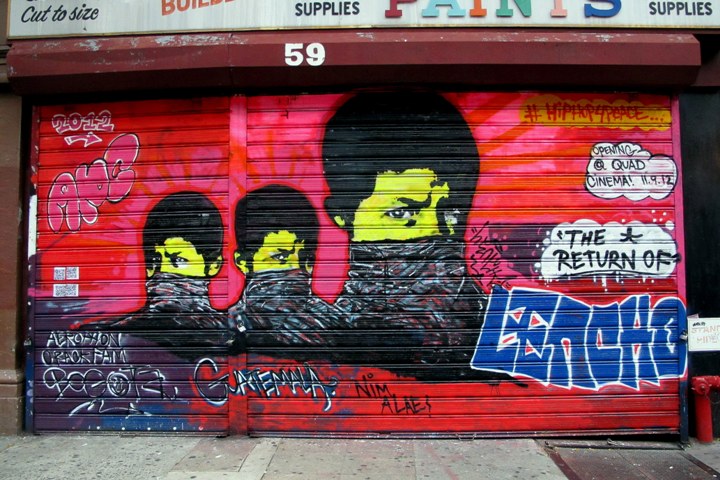In 2002, Mario Rosales left his native Guatemala to pursue an MFA in Media Arts Production at The City College of New York. In fall 2008, Mario began production on his first feature film “El Regreso de Lencho.” Presenting a poignant portrait of his country’s searing suppression of street art and hip-hop culture, “The Return of Lencho” begins a one-week run at Manhattan’s Quad Cinema, starting tomorrow.
You seem to blur the boundaries between artist/filmmaker and activist. What was your intent in this film?
My intent – as an artist — is to create awareness and, ultimately, bring about social and political change. The focus of The Return of Lencho is the state’s persecution of youth and street art culture.
Who is the inspiration for Lencho?
My younger brother. He was shot and tormented by the police in Guatemala for no reason. He was assumed to be a gang member simply because he has tattoos on his legs. My brother is an anthropologist. In the course of the film – ironically and tragically – one of the main actors, Carlos Chacon, aka El Chino, a graffiti and hip-hop artist, intent on passing his skills onto others, was assassinated. The movie is dedicated to his memory.
In The Return of Lencho graffiti is presented as a people’s movement that reclaims the streets from advertisements and desolation. What do you see as the role of graffiti in society?
The role of all art should be to give a voice to the people. In the 1980’s all of Guatemala’s expressive voices were silenced. An entire generation of artists, photographers and painters was annihilated. Graffiti represents the voice of the suppressed.
What do you see as the future of graffiti in your country?
It has begun to explode and I’m certain it will continue to do so.
The scene with the curator comes off as metaphorically rich. Is this particular curator modeled after someone in particular or is she simply a symbol of imperialism and warped values? The sex between Lencho and her seems quite hostile – with a reversal of roles, with her as the victim, almost as though she’s taking on the guilt of her entire race. Can you tell us something about what’s going on here and the kind of response it has elicited?
Yes, she is a symbol of an exploitive Western imperialism. I’ve had many responses to that scene. I’ve been asked, in fact, to remove it. That is how I know just how effective it is.
Was it difficult to get permission from the government to produce this film? Was it possible to get funding?
I promoted it as a film about muralism. We spoke to the ministry of culture, and we never talked about the film’s political content. The Guatemalan government does not provide any support at all for the arts unless you have a connection.
Who is the intended audience?
It is wide — from Guatemalans and Latin Americans and immigrants to a general audience in the U.S., particularly those people who are not aware of the impact of this country’s international policies.
You seem to imply a counter relationship between graffiti and globalization. Can you elaborate?
Globalization has become synonymous with colonization. Graffiti is a means to reclaim our spaces from global corporations. Yet at the same time — quite ironically — graffiti has become a world-wide movement as a result of globalization.
What’s next?
The U.S. theatrical premiere of The Return of Lencho will begin tomorrow, Friday, November 9th at the Quad Cinema and continue through the 15th. There will be Q&A’s after the 7:50pm show tomorrow and Saturday and after the 5pm show on Sunday. We plan to continue touring college campuses with the film and bring all the artists featured – Stinkfish, Bastardilla, Aeon and Soft – back to Guatemala early next year.
Photos of film stills featuring Stinkfish’s art courtesy of Mario Rosales and Occularis Films; photo of Lorenzo Masnah’s art on East Village shutter by Lois Stavsky.




Warning: count(): Parameter must be an array or an object that implements Countable in /srv/users/serverpilot/apps/streetartnyc/public/wp-content/themes/thesis_189/lib/classes/comments.php on line 43
{ 0 comments… add one now }